
One of the most popular attractions at
amusement and theme parks around the world is the train ride, offering
both a ride experience and a form of transportation. Traditional live
steam locomotives became the standard, utilizing steam engines that had
been retired from regular service. As those locomotives became more
scarce and expensive to restore, builders stepped up creating new steam
locomotives and rolling stock specifically designed for use as amusement
rides. The cost of maintaining steam engines and railroad equipment has
made it cost prohibitive for most parks to maintain operations, and
these traditional staples of parks have become more rare with each
passing year.
|
| |
|
|
 |
| |
|
|
 |

One of the first
attractions planned for Great Adventure was a train ride which would
serve as part of the immense park's transportation network. Along with
trains, plans were made for boats, skyrides, monorails and a wide range
of other vehicles to carry guests from a central parking area to the
various parks, resorts and attractions planned for the property.
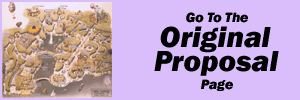
As the scope of the project was
modified to fit the restraints of time and budget, the Great Train Ride
was incorporated into the final design of the Enchanted Forest.
The design of the Great Train was a loop through the natural woodlands
along the lakes on a scenic journey. Great care was taken to preserve as
many trees as possible with the construction of the track much like the
rest of the park.
 |
 |
| |
|
 |
 |
| |
|
 |
 |
| |
|
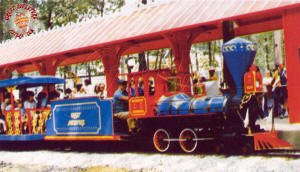 |
 |
| |
|
 |
 |
| |
|
|
 |

|
| |
 |
| |
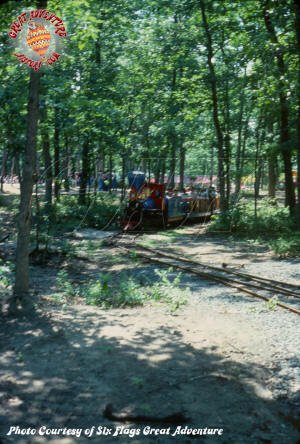 |
| |
|
|
 |


Over the life of the ride, the name was changed three times:
1974-1975 Great Train Ride
1976-1978 Woodland Express
1979-1980 Six Flags
Great Adventure Railroad.
The Great Train
ride's station was positioned just beyond the Skyride station. The
simple depot featured a covered platform and fanciful gingerbread style
decorations at the peak and along the edges. One of the most unique
features was the incorporation of a tree through a hole in the roof.
The roof of the station building featured an oversized semaphore
signal permanently set in the "station stop" position, signaling the
trains to stop. The oversized signal was in great contrast to the scaled
down trains.
The Great Train Ride originally featured two
locomotives and trains, with two additional trains being added for the
1975 season, doubling capacity. Three of the trains featured open cars painted in
matching colors with their respective engines. The fourth train featured
covered cars offering guests some protection from the elements, though
they still had open sides.
There were four identical 24" gauge
4-4-0 locomotives. They were built by Crown
Metal Products, who was a manufacturer of steam trains in varying sizes
for theme parks. The small engines were all propane fired, with the
tenders carrying large white propane tanks along with the water tank.
Train crews featured a single engineer who sat on a bench on the
front of the tender, with the gauges throttle and other controls mounted
on the firebox inside the cab.
The last car of each train
featured a high railing allowing a conductor to act as tour guide as
well as allow a clear view of the passengers and the engineer.
 |
 |
| |
|
 |
 |
| |
|
 |
 |
| |
|
 |
 |
| |
|

 |
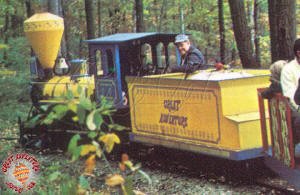
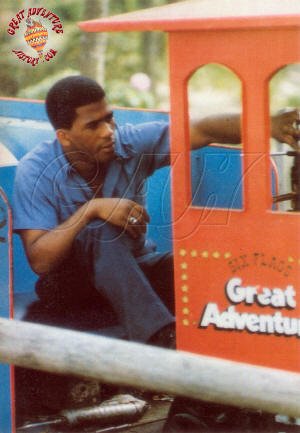 |
| |
|
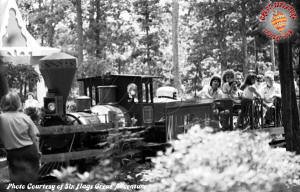 |
 |
| |
|
|
Click
the placard below for video of
The Great Train Ride:

|
 |
| |
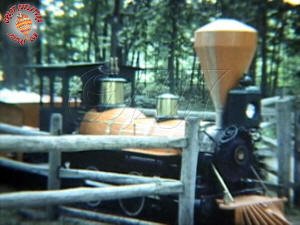 |
| |
|
|
 |
 |
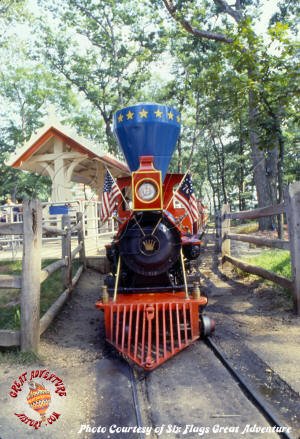 |
| |
|
|
 |
For the 1975 season,
the Hydro Flume was added to the wooded area that was home to the train,
with the flume trough winding above the treetops over the tracks. With
the addition of the flume a crossing was installed just to the right of the station
allowing access to the flume's queue.

The four locomotives were
brightly colored with the paint schemes of red cab with blue boiler
jacket, blue cab with yellow boiler jacket, black cab with orange boiler
jacket, and green cab with orange boiler jacket.
The track layout
featured a passing track that was parallel to the station track and an
additional storage siding parallel to that. An additional storage siding
was located alongside the splashdown of the flume and the propane
filling tank was located in the same area. A small water tower was
located near the station and passing track.The sites along the
rails were simply the trees and natural beauty of the surrounding area.
No props, scenery, or lightning were added to the journey prompting the
ride to close at dusk.
Often the train’s direction of travel was changed from
clockwise excursions around the rails to counter-clockwise trips.
This helped to balance out the wear and tear of the trains wheels and
stress on the trucks of the cars.
The Great Train Ride
was never able to fulfill its original purpose of acting as
transportation between parks. The expense of operating the trains became
too much, requiring skilled engineers and expertise in the operations of
live steam. The park approached the Pine Creek Railroad in nearby
Allaire Village to try and work out an agreement to run the Great Train,
but no arangements could be made.
With the mounting costs of
operations and the expansion of the park for the 1981 season with
Roaring Rapids, the Great Train Ride was removed, with the station
standing for another season. The rolling stock remained on site
for several seasons in storage behind Lightnin’ Loops in the maintenance
area. The cars could be seen from the reversing point while riding the
blue loop.
The roadbed for the train was
visible for many years, finally disappearing with the construction of
Adventure Rivers in 1991.
One of the few remnants of the
railroad resurfaced in 2004 when one of the original crossing signals
was used as a Fright Fest prop in the Brutal Planet haunted walk thru
which was set up in the Best of the West Shooting Gallery.

|
 |
| |
|
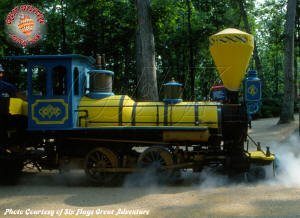 |
 |
| |
|
 |
 |
| |
|
 |
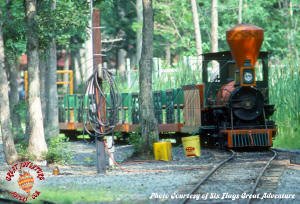 |
| |
|
 |
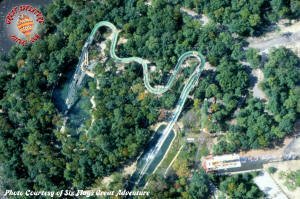 |
| |
|
 |
 |
| |
|
 |
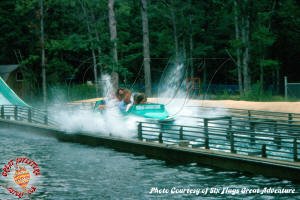 |
| |
|
 |
 |
| |
|
|
| |
|
Postcards
and
other
Souvenirs |
 |
| |
|
 |
 |
| |
|
The
Great Train Ride was featured
prominently on early park souvenirs
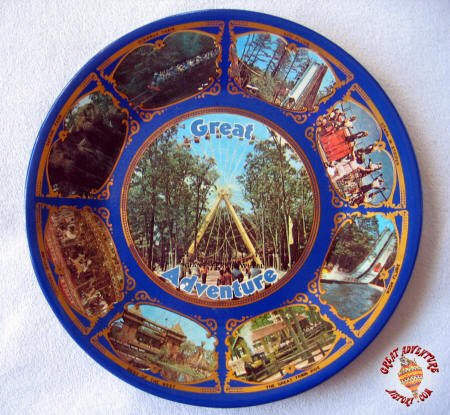 |
 |
| |
|
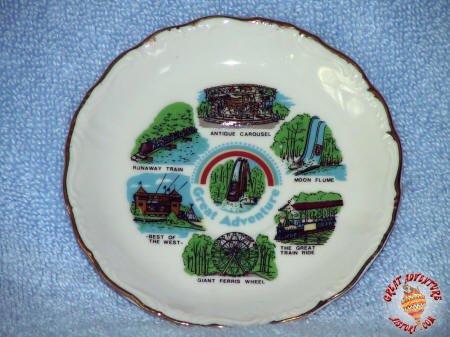 |
 |
| |
|
|




